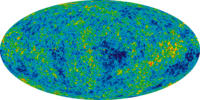
Photo from wikipedia
By carefully following the spatial and temporal criteria of the Debye-Hückel (DH) approximation, we present a detailed theoretical study on the redshifts of the spectroscopically isolated Heα lines corresponding to… Click to show full abstract
By carefully following the spatial and temporal criteria of the Debye-Hückel (DH) approximation, we present a detailed theoretical study on the redshifts of the spectroscopically isolated Heα lines corresponding to the 1s2p 1P → 1s2 S emission from two-electron ions embedded in external dense plasma. We first focus our study on the ratio R = ωα/ωo between the redshift ωα due to the external plasma environment and the energy ωo of the Heα line in the absence of the plasma. Interestingly, the result of our calculation shows that this ratio R turns out to vary as a nearly universal function of a reduced Debye length λD(Z) = (Z − 1)D. Since the ratio R dictates the necessary energy resolution for a quantitative measurement of the redshifts and, at the same time, the Debye length D is linked directly to the plasma density and temperature, the dependence of R on D should help to facilitate the potential experimental efforts for a quantitative measurement of the redshifts for the Heα line of the two-electron ions. In addition, our study has led to a nearly constant redshift ωα at a given D for all He-like ions with Z between 5 and 18 based on our recent critical assessment of the applicability of the DH approximation to atomic transitions. These two general features, if confirmed by observation, would offer a viable and easy alternative in the diagnostic efforts of the dense plasma.
Journal Title: Physical Review A
Year Published: 2017
Link to full text (if available)
Share on Social Media: Sign Up to like & get
recommendations!